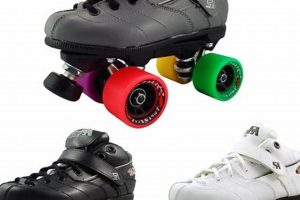The selection of appropriate footwear for male ice skaters involves several factors. These include intended use (recreational skating, hockey, figure skating), skill level, foot structure, and preferred fit. The optimal choice balances support, comfort, and performance characteristics tailored to individual needs.
Properly fitted and high-quality skating boots contribute significantly to a skater’s ability to control movements, maintain balance, and execute maneuvers effectively. Such footwear enhances the overall skating experience, reducing the risk of injury and allowing for improved skill development. Historically, advancements in materials and design have led to significant improvements in both performance and comfort.
The following discussion will address key considerations in choosing appropriate models, focusing on various categories, construction materials, fitting techniques, and maintenance practices that contribute to optimal performance and longevity.
Essential Considerations for Selecting Ice Skates
The selection of ice skates requires careful consideration of multiple factors. Optimal performance and safety are contingent upon a proper fit and suitability for the intended use. The following points offer guidance in making informed purchasing decisions.
Tip 1: Determine the Intended Use. Different skating disciplines (e.g., recreational, hockey, figure skating) require specific boot designs and blade configurations. Recreational skates prioritize comfort and ankle support, while hockey and figure skates offer greater stiffness and specialized blade profiles.
Tip 2: Prioritize Proper Fit. Ill-fitting skates can lead to discomfort, blisters, and impaired performance. Skates should fit snugly but not restrict circulation. Professional fitting services are recommended to ensure accurate sizing and address individual foot characteristics.
Tip 3: Evaluate Ankle Support. Adequate ankle support is crucial for stability and injury prevention. Stiffer boots generally provide greater support, particularly for beginners or individuals with weak ankles. More experienced skaters may prefer softer boots for increased flexibility.
Tip 4: Consider Blade Material and Quality. The blade’s steel type and finish significantly impact its performance. Higher-quality blades maintain their edge longer and provide improved glide. Regular sharpening is essential for optimal performance.
Tip 5: Inspect Boot Construction. The boot’s construction materials and manufacturing quality contribute to its durability and performance. Look for durable stitching, robust materials (e.g., leather, synthetic leather), and well-constructed soles.
Tip 6: Evaluate Liner and Padding. The liner provides cushioning and insulation. Look for moisture-wicking materials and adequate padding to enhance comfort and prevent chafing. Removable liners can be beneficial for drying and cleaning.
Tip 7: Account for Skill Level. Beginner skaters may benefit from more forgiving skates with softer boots and less aggressive blade profiles. Advanced skaters may require stiffer boots and more specialized blade designs to support advanced techniques.
Adhering to these guidelines ensures a more comfortable and effective skating experience. Thoughtful selection based on individual needs and preferences leads to improved performance and reduces the risk of injury.
The next section addresses specific models and brands frequently recommended within the skating community.
1. Fit
The correlation between proper fit and optimized skating performance is undeniable. In the context of selecting the most appropriate ice skates for men, the fit is a foundational element upon which all other attributes rely. An ill-fitting skate, regardless of its material quality or blade design, compromises control and increases the likelihood of discomfort and injury. For example, a skate that is too large results in excessive foot movement within the boot, diminishing power transfer and leading to blisters and chafing. Conversely, a skate that is too small restricts blood flow and causes pain, limiting the skater’s ability to perform intricate maneuvers or maintain endurance.
The selection process must consider both the length and width of the foot. Professional skate fitters utilize specialized measuring devices to determine these dimensions accurately. Furthermore, the volume and shape of the foot should be evaluated to identify potential pressure points or areas requiring customized adjustments. Heat molding, a common practice, allows the skate’s internal structure to conform more closely to the individual’s foot, addressing minor discrepancies and enhancing overall comfort. Skates that accommodate orthotics provide an additional layer of customization for those with specific foot conditions, such as flat feet or high arches.
In summary, the proper fit of ice skates for men is not merely a matter of comfort but a critical determinant of performance and safety. Attention to detail during the fitting process, combined with the utilization of professional services and available customization options, significantly improves the skating experience. Ignoring fit leads to suboptimal performance, potential injuries, and a diminished enjoyment of the sport. Ensuring the correct fit is, therefore, a paramount consideration when choosing the best possible ice skates.
2. Support
Adequate support is a crucial determinant in the categorization of ice skates. The design characteristics influencing support dictate skater stability, movement control, and injury prevention. Insufficient support results in ankle instability, compromised balance, and a diminished ability to execute technical maneuvers. Conversely, excessive support can restrict mobility, impeding the skater’s range of motion and limiting performance potential. Therefore, the degree of support must be carefully calibrated to match the skater’s skill level, skating style, and physical characteristics.
Hockey skates, for instance, necessitate rigid ankle support to withstand the lateral forces generated during aggressive skating, rapid turns, and physical contact. Reinforced materials and specific lacing patterns are employed to provide the requisite stability. Figure skates, conversely, require a more nuanced approach. While ankle support remains essential, a degree of flexibility is necessary to facilitate intricate footwork, jumps, and spins. Accordingly, figure skates typically feature a softer boot construction in the upper ankle region, allowing for greater range of motion. Recreational skates, designed primarily for casual skating, generally offer a lower level of support, prioritizing comfort over high-performance characteristics. These models often utilize softer materials and a less restrictive design.
In summary, support represents a critical factor when selecting appropriate ice skates. Balancing stability and mobility is crucial for optimal performance and safety. The specific requirements dictated by the skating discipline, skill level, and individual physical attributes should guide the selection process. Therefore, consider support a key factor in best mens ice skates.
3. Blade Quality
The performance and lifespan of men’s ice skates are inextricably linked to the quality of their blades. Blade quality directly impacts a skater’s ability to maintain edges, execute precise movements, and control speed. Inferior blade steel dulls quickly, requiring frequent sharpening and diminishing the skater’s ability to perform intricate maneuvers. Conversely, high-quality blades, crafted from hardened steel alloys, retain their edge longer, providing enhanced glide and control. For instance, a figure skater relying on a blade with poor edge retention may struggle to land jumps consistently, while a hockey player could experience reduced agility and control during high-speed turns. Therefore, blade quality constitutes a critical component in determining the overall value and effectiveness of any pair of men’s ice skates.
The type of steel used, along with the blade’s tempering and hardening processes, determines its resistance to wear and corrosion. High-carbon steel blades offer superior edge retention compared to stainless steel options, although they may require more diligent maintenance to prevent rust. Blade profiles also vary, influencing maneuverability and speed. Aggressive profiles, common in hockey skates, facilitate quick turns, while flatter profiles, often found in recreational skates, provide greater stability. Furthermore, the blade’s mounting system affects its rigidity and responsiveness. A securely mounted blade ensures efficient power transfer from the skater’s foot to the ice, minimizing energy loss and maximizing performance.
In conclusion, the relationship between blade quality and the overall performance of ice skates for men is undeniable. Selecting skates with high-quality blades ensures improved edge retention, enhanced control, and increased durability. While blade quality often corresponds to a higher initial cost, the long-term benefits in terms of performance, safety, and reduced maintenance justify the investment. Therefore, evaluating blade quality is a critical step in selecting the most suitable ice skates for any male skater, regardless of their skill level or skating discipline.
4. Intended Use
The selection process for appropriate ice skates begins with a clear understanding of the intended use. This foundational element directly determines the necessary features, construction, and performance characteristics of the selected skate. Mismatching the skate to the intended activity results in suboptimal performance, increased risk of injury, and accelerated wear.
- Recreational Skating
Recreational skating emphasizes comfort and general usability. Skates designed for this purpose typically feature softer boot construction, prioritizing ankle support and ease of use over specialized performance attributes. Blade profiles are generally flatter, providing enhanced stability for novice skaters. Recreational skates often incorporate additional padding and moisture-wicking liners to enhance comfort during extended periods of use.
- Hockey
Hockey skates are engineered for high-performance skating, characterized by rapid acceleration, sharp turns, and aggressive stops. These skates feature rigid boot construction, providing maximum ankle support and protection from impacts. Blade profiles are more aggressive, facilitating quick turns and enhanced maneuverability. Hockey skates are typically heat-moldable to provide a customized fit, enhancing power transfer and control. The robust construction materials withstand the rigors of competitive play.
- Figure Skating
Figure skates are uniquely designed to facilitate intricate footwork, jumps, spins, and landings. These skates feature a specialized blade with a toe pick, enabling skaters to execute complex maneuvers. The boot construction balances ankle support with a degree of flexibility, allowing for a greater range of motion. Figure skates require precise fitting to ensure optimal control and responsiveness. The elevated heel contributes to the skater’s balance and posture.
- Speed Skating
Speed skates prioritize efficiency and velocity. These skates feature long, narrow blades that maximize glide and minimize friction. The boot construction is typically low-cut, allowing for a greater range of motion and facilitating the skater’s characteristic crouched posture. Speed skates are designed for use on oval tracks and require specialized technique and skill. The blade is directly attached to the boot to optimize power transfer.
In summary, the “best mens ice skates” selection hinges critically on the intended use. Selecting skates designed specifically for the skater’s activity ensures optimal performance, safety, and longevity. Ignoring this primary factor often leads to compromised performance, increased risk of injury, and a less enjoyable skating experience.
5. Durability
The concept of durability is central to evaluating the suitability of any pair of ice skates. Skates subjected to frequent use or rigorous conditions necessitate robust construction and resilient materials to maintain their integrity and performance over an extended period. Selecting skates lacking durability leads to premature wear, compromised safety, and increased replacement costs.
- Material Quality and Construction
The types of materials used and the methods of construction employed directly impact a skate’s ability to withstand stress and resist degradation. Skates constructed from high-quality leather or synthetic materials, featuring reinforced stitching and robust sole attachments, typically exhibit greater resistance to abrasion, tearing, and deformation. For example, skates used in competitive hockey require significantly stronger materials than those intended for recreational skating due to the increased physical demands of the sport. The integrity of seams and attachment points is paramount in preventing premature failure.
- Blade Material and Hardness
The hardness and composition of the blade steel determine its resistance to wear and corrosion. Higher-quality steel alloys maintain their edge for longer periods and are less susceptible to damage from impacts or contaminants. A blade that dulls quickly or corrodes easily compromises the skater’s control and requires frequent sharpening or replacement. The blade’s mounting system also contributes to overall durability; a secure and well-supported mounting minimizes stress on the blade and prevents loosening or detachment.
- Liner and Padding Resilience
The liner and padding materials within the skate boot provide cushioning, insulation, and moisture management. These components are subjected to constant friction and compression, leading to wear and degradation over time. High-density foams and abrasion-resistant fabrics retain their shape and functionality longer, providing sustained comfort and support. Liners that readily compress or tear compromise the skate’s fit and can lead to blisters and discomfort.
- Hardware and Fastener Integrity
The durability of buckles, laces, eyelets, and other hardware components is crucial for ensuring a secure and reliable fit. Fasteners constructed from corrosion-resistant materials and designed to withstand repeated tightening and loosening prevent premature failure. Broken buckles or frayed laces compromise the skate’s ability to provide adequate support and can pose a safety hazard.
The facets of durability outlined above are interconnected and collectively determine the overall longevity and reliability of ice skates. Selecting skates that prioritize these aspects ensures a greater return on investment, reduced maintenance costs, and a safer, more enjoyable skating experience. The “best mens ice skates” are those that demonstrate a commitment to durability in all aspects of their design and construction.
6. Skill Level
The skater’s skill level exerts a significant influence on the appropriate selection of ice skates. Entry-level models differ substantially from those designed for advanced or professional users. The optimal choice aligns with the skater’s technical proficiency and physical capabilities to maximize performance and minimize the risk of injury.
- Boot Stiffness and Support
Beginner skaters benefit from boots offering increased ankle support and stiffness. This design helps stabilize the foot and ankle, improving balance and control during initial learning phases. Conversely, advanced skaters often prefer boots with greater flexibility, facilitating complex maneuvers and optimizing responsiveness. The stiffness of the boot directly correlates with the skater’s ability to execute advanced techniques.
- Blade Profile and Radius
Blade profile and radius are critical considerations when matching skates to skill level. Beginner skates typically feature a flatter blade profile, enhancing stability and promoting easier gliding. Advanced skaters require a more pronounced rocker, enabling tighter turns and increased agility. The blade radius influences edge control and the ability to perform specific skating techniques. Adjustments to blade profile become increasingly important as skill level progresses.
- Material Composition and Weight
The materials used in skate construction impact weight and responsiveness. Beginner skates often utilize heavier, more durable materials to withstand initial wear and tear. Advanced skates prioritize lightweight materials, enhancing agility and reducing fatigue during prolonged skating sessions. The skater’s physical strength and technical proficiency determine the optimal balance between durability and weight.
- Customization and Adjustability
Entry-level skates typically offer limited customization options, focusing on basic fit and comfort. Advanced skates provide extensive customization features, allowing skaters to fine-tune the fit, blade alignment, and support characteristics. The ability to personalize skate features becomes increasingly important as skill level advances, enabling skaters to optimize performance and address individual biomechanical needs.
Selecting ice skates that correspond to the skater’s skill level is paramount for promoting safe and effective skill development. Choosing skates that are either too advanced or too basic can hinder progress and increase the risk of injury. The facets outlined above emphasize the importance of aligning equipment selection with the skater’s current abilities and future aspirations. Ultimately, prioritizing the proper fit, support, blade characteristics, and customization options ensures an optimal skating experience.
Frequently Asked Questions
This section addresses common inquiries concerning the selection, maintenance, and performance of ice skates, providing concise and informative answers.
Question 1: What factors dictate the appropriate size selection for ice skates?
Accurate sizing necessitates measuring both foot length and width. Consultation with a professional skate fitter is recommended to account for individual foot morphology. Allowance for sock thickness is also crucial; skates should fit snugly but not restrict circulation.
Question 2: How frequently should ice skate blades be sharpened?
Sharpening frequency depends on usage intensity and ice conditions. Visual inspection for dullness or nicks is recommended. Professional sharpening services are required to maintain proper blade geometry and edge quality. A general guideline is every 10-20 hours of skating.
Question 3: What distinguishes hockey skates from figure skates?
Hockey skates emphasize ankle support, agility, and protection. Figure skates prioritize flexibility, blade design for jumps, and elevated heels. Blade profiles and boot stiffness differ significantly based on the demands of each discipline.
Question 4: What is the expected lifespan of quality ice skates?
Lifespan varies depending on usage frequency, maintenance practices, and construction quality. With proper care, high-quality skates can last several years. Regular cleaning, blade protection, and timely repairs contribute to longevity.
Question 5: How does skill level impact skate selection?
Beginner skaters benefit from increased ankle support and forgiving blade profiles. Advanced skaters require greater boot stiffness, specialized blade designs, and enhanced customization options to optimize performance.
Question 6: What are the key indicators of ill-fitting ice skates?
Symptoms of ill-fitting skates include blisters, numbness, heel slippage, and restricted toe movement. A proper fit ensures secure ankle support without compromising circulation or comfort. Prompt adjustment or replacement is necessary to prevent injury.
Selecting and maintaining quality ice skates requires diligent attention to detail. Addressing these frequently asked questions contributes to informed decision-making and optimal skating performance.
The subsequent section will delve into specific product recommendations within various categories.
Conclusion
The preceding discussion explored the multifaceted considerations inherent in choosing the “best mens ice skates.” Fit, support, blade quality, intended use, durability, and skill level were identified as critical factors influencing performance and safety. Proper evaluation of these elements ensures informed purchasing decisions aligned with individual needs and skating objectives. Compromises in any of these areas directly impact a skater’s ability to execute maneuvers effectively and safely.
Ultimately, the selection represents a commitment to both performance and personal well-being. Continued advancements in materials and design promise further enhancements in skating technology. Rigorous evaluation of individual requirements, coupled with informed product assessment, facilitates the acquisition of equipment conducive to optimal skating experiences. The investment in appropriate skating equipment yields long-term benefits, fostering skill development and minimizing the potential for injury.







